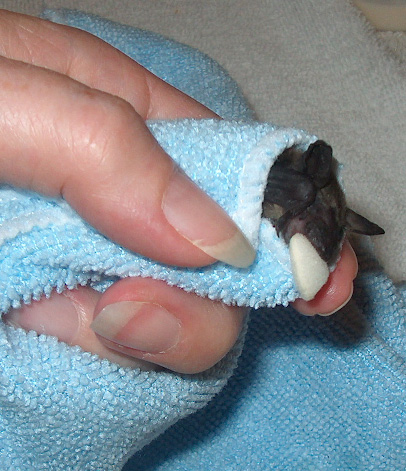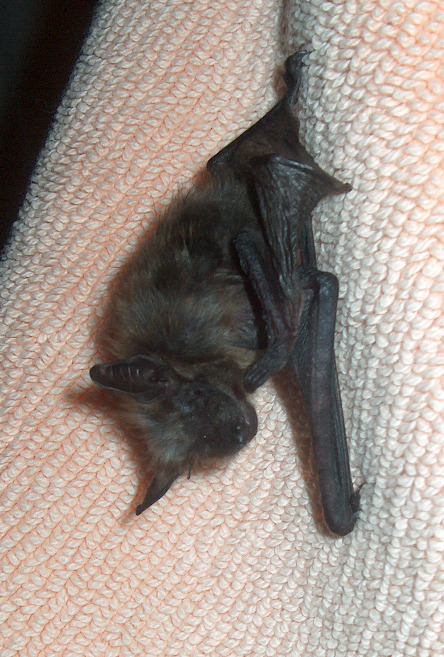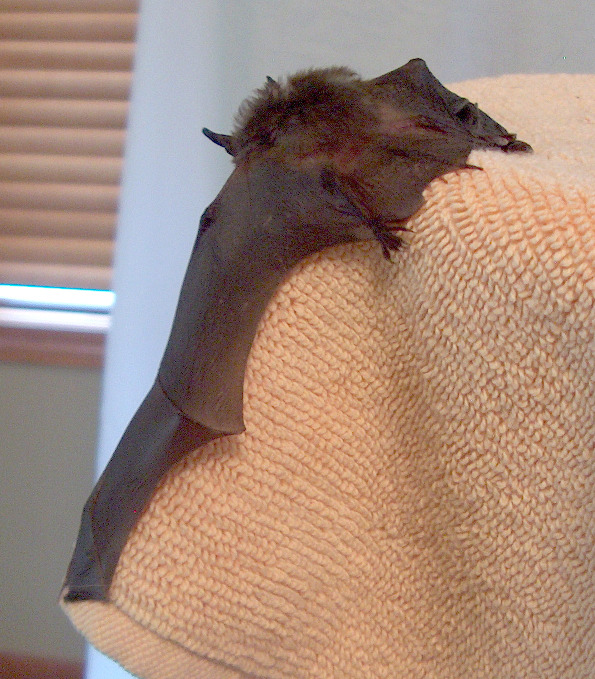One night in early July, we found a bat in our house. As this has happened in the past, we caught it in a net and released it outdoors. Well, two days later, I found a tiny baby bat lying on the carpet in my room. He was very obviously an infant and must have crawled out from beneath a piece of furniture. I immediately gave him some sugar-water, then researched what kind of bat he might be and what to do. I learned that a mother bat will carry her baby, clinging to her abdomen, during the first 2 weeks of life. Sometimes she'll stash him someplace safe and pick him up later. Since there was no way I could put him back in the nest or return him to mom, I had to keep him and feed him. I named him Lugosi.
I did a lot of research for identification and tips on feeding. Lugosi is a "Big Brown Bat" which is very common to North America. He eats insects like mosquitoes and moths. For the next 5 to 6 weeks I fed and cared for my little bat until he was flying on his own. He was like a small puppy. He would come to me when I called and crawl right up my arm to snuggle under my shirt collar. When it was time to go outside the night of his release, he was so excited. He made a short flight, then crawled back to me. With a bit of urging he took off again to a nearby tree, then from there he crawled up the trunk to get some height, then took off again to soar above the treetops. Almost immediately he was joined by two other bats, one his same size and one a little bit larger. So, I'm hoping it was his sibling and mother. They flew around together, catching bugs and swooping, until it got full-dark and I lost sight of them. We've seen him and his family again from time to time, typically at dusk.
Here's some baby pics.



Lugosi on day 3 in my care — I estimated his actual age to be about 10 to 14 days. All swaddled up and suckling from a soft eye-applicator sponge. For the first couple weeks I fed him a special goat's milk formula recommended by several bat experts. It's super important he gets the right amount of nutrients so his wing bones grow strong and straight, or he may never be able to fly.



Lugosi crawling around on my hand. He would readily hang upside down from just about everything, which indicated he was healthy. A rabid bat will typically appear listless and not have the strength to hang. I was warned by all the bat experts to wear gloves. After I monitored him for several days and determined he was not sick, I shed the gloves. He seemed to prefer the warm touch. I was probably taking a risk, but at this point he had no teeth to speak of and his mouth was too small to even take a bite.
His eyes had yet to fully open, but when he blinked, it was like seeing a tiny pinprick of black. He has sleek soft fur on his body, but not on his wings. Lugosi, age about 4 to 5 weeks. His fur is lighter and fuzzy.

Looks like a tiny puppy with wings.

Smiling for the camera.

Scratching his chin with his back foot.

Lugosi stretching his wing, just about ready to be released.
He's got some very sharp teeth! He's been munching on whole mealworms for a couple weeks and is being gradually weaned from the goat's milk. He never bit me, thankfully.
At each feeding I would urge him to flap his wings and eventually he graduated to making short flights from my hand to various pieces of furniture covered with towels. I wanted his muscles to be strong for his eventual release into the world. He will grow to be 4 to 5 inches from nose to tail with a total wingspan of 10 to 13 inches.
Here a few interesting facts I learned:
1. Bats give birth only once a year, and have only 1 or 2 babies per birth. They are the only flying mammals in the world.
2. Male bats are smaller than females.
3. A small colony of this type of bat can eat thousands of flying insects each night. That includes mosquitoes and gnats.
For more info: BatConservation.org
Well, that should put us all in a warm, fuzzy Halloween spirit!
—Christine
